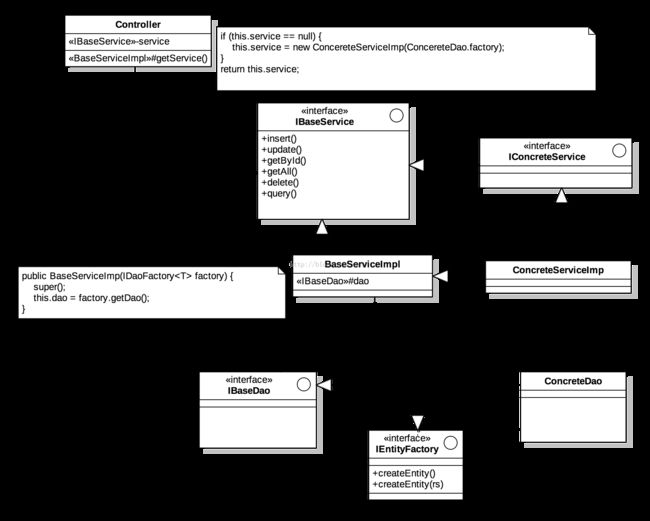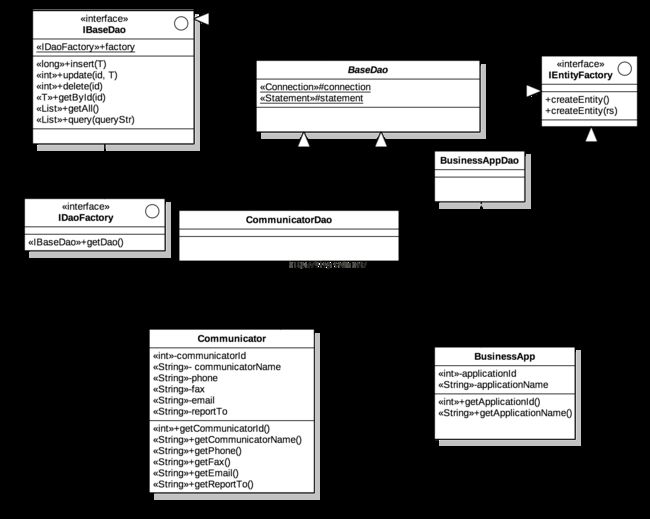第一次尝试着用Java做Web开发,使用了Java Spring框架,顺便说一句,如果使用Spring开发,建议使用STS(Spring Tool Suite) IDE,它很好的集成了Spring、Maven等框架,使用起来特别方便,尤其是第一次使用Spring框架进行开发,它极大的方便了开发人员,通过快捷菜单及可很简单的配置好Spring开发环境,自动下载、更新Maven依赖包。话不多讲,回到文章的正题。
Spring是一个在Java业界很流行的MVC框架,所谓MVC即模型-视图-控制器,将应用程序的逻辑层与展现层进行分离的一种设计模式。
- 模型(Model)代表数据控制器。数据的读取,插入,更新都是由模型来负责。
- 视图(View)是展示给用户的最终页面。视图负责将数据以用户友好的形式展现出来。
- 控制器(Controller)是模型,视图以及其他任何处理HTTP请求所必须的资源之前的中介
概述
一个典型的页面浏览行为在程序端的流程是这样的:
- 控制器最先被调用,并被赋予外部输入
- 控制器根据外部输入向模型请求数据
- 模型从数据库获取数据并发送数据到控制器
- 控制器处理该数据并发送封装好的数据到视图
- 视图根据接到的数据最终展示页面给用户浏览
使用Java进行MVC模式开发时,往往将数据模型分为两部分,即DAO(Data Access Object,数据访问对象)和Service(业务逻辑模型)。在第2步中,控制器向模型请求数据时,并不是直接向DAO请求数据,而是通过Service向DAO请求数据。这样做的好处是,可以将业务逻辑与数据库访问独立开,为将来系统更换数据保存介质(如目前系统使用文件系统存储数据,将来可以更换为使用数据库存储,又或者是现在使用了MSSQL存储数据,将来更换为Oracle或是Mysql等)提供了很大的灵活性。
下图给出了分层设计模型。控制器只需要调用Service接口中的方法获取或是处理数据,Service层对控制器传入的数据进行业务逻辑处理封装后,传给DAO层,由DAO层负责将处理后的数据写入数据库中。
在Service层使用了抽象工厂模式来实现Service层与DAO层的低耦合,Service层并不知道DAO层是如何实现的,实际上也不需要知道系统使用了哪种数据库或是文件系统。
在DAO层使用工厂模式来创建数据模型的实体对象。
Service层设计
接口代码,这里使用了泛型技巧,确保每个Service只处理一种数据类型。
package com.emerson.etao.service;
import java.sql.SQLException;
import java.util.List;
/**
* 业务实现层接口
*
* @author Chris Mao(Zibing)
*
* @param <T>
*/
public interface IBaseService<T> {
/**
* 将实体类对象持久化,写入到数据表中
*
* @param T
* @return 返回新写入记录的自增ID
* @throws SQLException
*/
public long insert(T entity);
/**
* 根据Id值,将实体类数据回写到数据库
*
* @param id
* @param T
* @return 返回更新的记录笔数
* @throws SQLException
*/
public int update(long id, T entity);
/**
* 根据Id值从数据库中删除实体类数据
*
* @param id
* @return 返回删除的记录笔数
* @throws SQLException
*/
public int delete(long id);
/**
* 根据Id查询具体的实体类信息,并返回实体类对象
* 若查询不到数据则返回null
*
* @param id
* @return T
*/
public T getById(long id);
/**
* 获取列表
*
* @return List
* @throws SQLException
*/
public List<T> getAll();
}
下面是具体的Service层接口代码,
package com.emerson.etao.service.base;
import java.util.List;
import com.emerson.etao.entity.base.BusinessApp;
import com.emerson.etao.entity.base.Communicator;
import com.emerson.etao.entity.base.Customer;
import com.emerson.etao.service.IBaseService;
/**
* 客服类操作接口
*
* @author Chris Mao(Zibing)
* @param <T>
*
* @param <T>
*/
public interface ICommunicatorService extends IBaseService<Communicator> {
public List<Communicator> getAll(Customer customer);
/**
* 为客服分配商业应用
*
* @param c
* @param appList
* @see BusinessApp
*/
public void assignBusinessApp(Communicator communicator, List<BusinessApp> appList, boolean deleteExists);
/**
* 为客服分配客户
*
* @param c
* @param customerList
* @see Customer
*/
public void assingCustomer(Communicator communicator, List<Customer> customerList, boolean deleteExists);
}
实现接口。
/**
*
*/
package com.emerson.etao.service.imp;
import java.sql.SQLException;
import java.util.List;
import com.emerson.etao.dao.IBaseDao;
import com.emerson.etao.dao.IDaoFactory;
import com.emerson.etao.service.IBaseService;
/**
* 业务层实现类基类
*
* 为了降低与数据访问层的耦合,在构造函数中传入DaoFactory接口用于创建具体的数据访问对象实例
*
* @author Chris Mao(Zibing)
*
*/
public abstract class BaseServiceImp<T> implements IBaseService<T> {
private IBaseDao<T> dao = null;
protected IBaseDao<T> getDao() {
return this.dao;
}
/**
*
* @param factory 降低耦合,传入DaoFactory接口
* @see IDaoFactory
*/
public BaseServiceImp(IDaoFactory<T> factory) {
super();
this.dao = factory.getDao();
}
@Override
public long insert(T entity) {
try {
return this.getDao().insert(entity);
} catch (SQLException e) {
e.printStackTrace();
}
return 0;
}
@Override
public int update(long id, T entity) {
try {
return this.getDao().update(id, entity);
} catch (SQLException e) {
e.printStackTrace();
}
return 0;
}
@Override
public int delete(long id) {
try {
return this.getDao().delete(id);
} catch (SQLException e) {
e.printStackTrace();
}
return 0;
}
@Override
public List<T> getAll() {
try {
return this.getDao().getAll();
} catch (SQLException e) {
e.printStackTrace();
}
return null;
}
@Override
public T getById(long id) {
try {
return this.getDao().getById(id);
} catch (SQLException e1) {
e1.printStackTrace();
}
return null;
}
}
package com.emerson.etao.service.base.imp;
import java.sql.PreparedStatement;
import java.sql.SQLException;
import java.text.SimpleDateFormat;
import java.util.ArrayList;
import java.util.Date;
import java.util.Iterator;
import java.util.List;
import com.emerson.etao.dao.IDaoFactory;
import com.emerson.etao.entity.base.BusinessApp;
import com.emerson.etao.entity.base.Communicator;
import com.emerson.etao.entity.base.Customer;
import com.emerson.etao.service.base.ICommunicatorService;
import com.emerson.etao.service.imp.BaseServiceImp;
/**
*
* @author Chris Mao(Zibing)
*
*/
public class CommunicatorServiceImp extends BaseServiceImp<Communicator>implements ICommunicatorService {
@Override
public List<Communicator> getAll(Customer customer) {
List<Communicator> result = new ArrayList<Communicator>();
try {
result = this.getDao()
.getAll("SELECT a.* FROM communicator AS a INNER JOIN customer_communicator cc USING(communicator_id) WHERE cc.customer_id = "
+ customer.getCustomerId());
} catch (SQLException e) {
e.printStackTrace();
}
return result;
}
public CommunicatorServiceImp(IDaoFactory<Communicator> factory) {
super(factory);
}
@Override
public void assignBusinessApp(Communicator communicator, List<BusinessApp> appList, boolean deleteExists) {
try {
if (true == deleteExists) {
this.getDao().getStatement().executeUpdate("DELETE FROM communicator_application WHERE communicator_id = " + communicator.getCommunicatorId());
}
if (null == appList || appList.isEmpty()) {
return;
}
PreparedStatement pstmt = this.getDao().getConnection().prepareStatement("INSERT IGNORE INTO communicator_application(communicator_id, application_id, created_time) VALUES(?, ?, ?)");
BusinessApp app = null;
SimpleDateFormat sdf = new SimpleDateFormat("yyyy-MM-dd HH:mm:ss");// 设置日期格式
Iterator<BusinessApp> ite = appList.iterator();
while (ite.hasNext()) {
app = ite.next();
pstmt.setLong(1, communicator.getCommunicatorId());
pstmt.setLong(2, app.getApplicationId());
pstmt.setString(3, sdf.format(new Date()));
pstmt.executeUpdate();
}
pstmt.close();
} catch (SQLException e) {
e.printStackTrace();
}
}
/**
* 为客服人员分配客户
*
* 如果需要删除客服人员名下所有客户,只需将customers设为null或是空列表
*
* @param communicator
* @param apps
* @param deleteExists
*/
@Override
public void assingCustomer(Communicator communicator, List<Customer> customerList, boolean deleteExists) {
try {
if (true == deleteExists) {
this.getDao().getStatement().executeQuery("DELETE FROM customer_communicator WHERE communicator_id = " + communicator.getCommunicatorId());
}
if (null == customerList || customerList.isEmpty()) {
return;
}
PreparedStatement pstmt = this.getDao().getConnection().prepareStatement("INSERT IGNORE INTO customer_communicator(communicator_id, customer_id, created_time) VALUES(?, ?, ?)");
Customer customer = null;
SimpleDateFormat sdf = new SimpleDateFormat("yyyy-MM-dd HH:mm:ss");// 设置日期格式
Iterator<Customer> ite = customerList.iterator();
while (ite.hasNext()) {
customer = ite.next();
pstmt.setLong(1, communicator.getCommunicatorId());
pstmt.setLong(2, customer.getCustomerId());
pstmt.setString(3, sdf.format(new Date()));
pstmt.executeUpdate();
}
pstmt.close();
} catch (SQLException e) {
e.printStackTrace();
}
}
}
DAO层的设计
这里需在为DAO层定义一个通个的基础接口IBaseDao,这里包含了对数据的增、删、改、查基础操作。抽象类BaseDao实现接口IBaseDao,并添加了访问限制为protected的数据库连接对象,方便子类使用。
DAO接口代码。
/**
*
*/
package com.emerson.etao.dao;
import java.sql.Connection;
import java.sql.SQLException;
import java.sql.Statement;
import java.util.List;
/**
*
* 数据访问层接口
*
* @author Chris Mao(Zibing)
*
*/
public interface IBaseDao<T> {
/**
*
* @return Connection
*/
public Connection getConnection();
/**
*
* @return Statement
*/
public Statement getStatement();
/**
* 将值对象写入到数据表中,并返回其自增ID值
*
* @param entity
* @return 返回新写入记录的自增ID
* @throws SQLException
*/
public long insert(T entity) throws SQLException;
/**
* 将值对象修改后的内容写入到数据表中,并返回其影响的记录笔数
*
* @param id
* @param entity
* @return 返回更新的记录笔数
* @throws SQLException
*/
public int update(long id, T entity) throws SQLException;
/**
* 删除ID值,并返回其删除的记录笔数
*
* @param id
* @return 返回删除的记录笔数
* @throws SQLException
*/
public int delete(long id) throws SQLException;
/**
* 依据Id值到数据表中查询数据,并返回值对象
*
* @param id
* @return
*/
public T getById(long id) throws SQLException;
/**
* 返回数据表中所有记录
*
* @return List<T>
* @throws SQLException
*/
public List<T> getAll() throws SQLException;
/**
* 返回符合条件的所有记录
*
* @param queryStr
* @return List<T>
* @throws SQLException
*/
public List<T> getAll(String queryStr) throws SQLException;
}
抽象工厂接口。
package com.emerson.etao.dao;
/**
* 数据访问类工厂接口
*
* 负责创建具体的数据访问对象实例
*
* @author Chris Mao(Zibing)
*
* @param <T>
*/
public interface IDaoFactory<T> {
/**
* 创建数据访问对象实例
*
* @return
* @see IBaseDao
*/
public IBaseDao<T> getDao();
}
抽象类BaseDao实现接口IBaseDao。
package com.emerson.etao.dao;
import java.sql.Connection;
import java.sql.ResultSet;
import java.sql.SQLException;
import java.sql.Statement;
import org.slf4j.Logger;
import org.slf4j.LoggerFactory;
import com.emerson.etao.db.DBUtils;
/**
*
* 数据访问层基类
*
* 所有数据访问对象都需要继承此类
*
* @author Chris Mao(Zibing)
*
*/
public abstract class BaseDao<T> implements IBaseDao<T> {
private static final Logger logger = LoggerFactory.getLogger(BaseDao.class);
public Connection getConnection() {
return DBUtils.getConnection();
}
public Statement getStatement() {
Statement stmt = null;
try {
Connection conn = DBUtils.getConnection();
stmt = conn.createStatement(ResultSet.TYPE_FORWARD_ONLY, ResultSet.CONCUR_READ_ONLY);
} catch (SQLException e) {
logger.error("创建 Statement 对象发生错误!!");
e.printStackTrace();
}
return stmt;
}
}
实体类创建工厂接口。
package com.emerson.etao.entity;
import java.sql.ResultSet;
/**
*
* 实体类工厂接口
*
* 所有实体类对象实例需要通过此工厂接口创建
*
* @author Chris Mao(Zibing)
*
*/
public interface IEntityFactory<T> {
/**
* 创建空的实体类
*
* @return
*/
public T createEntity();
/**
* 创建实体类,并将参数rs中的内容赋值到实体类属性当中
*
* @param rs
* @return
*/
public T createEntity(ResultSet rs);
}
具体的DAO对象,继承BaseDao,并实现实体类创建工厂接口。这里使用了内部匿名类实现DAO的抽象工厂接口。
package com.emerson.etao.dao.base;
import java.sql.PreparedStatement;
import java.sql.ResultSet;
import java.sql.SQLException;
import java.sql.Statement;
import java.text.SimpleDateFormat;
import java.util.ArrayList;
import java.util.Date;
import java.util.List;
import com.emerson.etao.dao.BaseDao;
import com.emerson.etao.dao.IBaseDao;
import com.emerson.etao.dao.IDaoFactory;
import com.emerson.etao.entity.IEntityFactory;
import com.emerson.etao.entity.base.Communicator;
/**
* 客服人员数据访问对象
*
* @author Chris Mao(Zibing)
*
*/
public class CommunicatorDao extends BaseDao<Communicator>implements IEntityFactory<Communicator> {
public static IDaoFactory<Communicator> factory = new IDaoFactory<Communicator>() {
@Override
public IBaseDao<Communicator> getDao() {
return new CommunicatorDao();
}
};
@Override
public Communicator createEntity() {
return new Communicator();
}
@Override
public Communicator createEntity(ResultSet rs) {
Communicator c = this.createEntity();
try {
c.setCommunicatorId(rs.getInt("communicator_id"));
c.setCommunicatorName(rs.getString("communicator_name"));
c.setPhone(rs.getString("phone"));
c.setFax(rs.getString("fax"));
c.setEmail(rs.getString("email"));
c.setReportTo(rs.getInt("report_to"));
c.setReportToName(rs.getString("report_to_name"));
c.setValid(rs.getByte("is_valid"));
c.setCreatedTime(rs.getTimestamp("created_time"));
c.setUpdatedTime(rs.getTimestamp("update_time"));
} catch (SQLException e) {
e.printStackTrace();
}
return c;
}
@Override
public Communicator getById(long id) throws SQLException {
Communicator result = null;
ResultSet rs = this.getStatement().executeQuery("SELECT * FROM vw_communicator WHERE communicator_id = " + id);
while (rs.next()) {
result = this.createEntity(rs);
}
rs.close();
return result;
}
@Override
public long insert(Communicator entity) throws SQLException {
Long newId = (long) 0;
StringBuilder sql = new StringBuilder();
sql.append("INSERT IGNORE INTO communicator");
sql.append("(communicator_name, phone, fax, email, report_to, created_time) ");
sql.append("VALUES(?, ? ,? ,?, ?, ?)");
PreparedStatement pstmt = this.getConnection().prepareStatement(sql.toString(), Statement.RETURN_GENERATED_KEYS);
pstmt.setString(1, entity.getCommunicatorName());
pstmt.setString(2, entity.getPhone());
pstmt.setString(3, entity.getFax());
pstmt.setString(3, entity.getFax());
pstmt.setString(4, entity.getEmail());
pstmt.setInt(5, entity.getReportTo());
SimpleDateFormat df = new SimpleDateFormat("yyyy-MM-dd HH:mm:ss");// 设置日期格式
pstmt.setString(6, df.format(new Date()));
pstmt.executeUpdate();
ResultSet rs = pstmt.getGeneratedKeys();
if (rs.next()) {
newId = rs.getLong(1);
entity.setCommunicatorId(rs.getInt(1));
// System.out.println("新增客服记录ID为:" + newId);
}
rs.close();
pstmt.close();
return newId;
}
@Override
public int update(long id, Communicator entiry) throws SQLException {
int result = 0;
StringBuffer sql = new StringBuffer();
Communicator c = (Communicator) entiry;
// System.out.println(c);
sql.append("UPDATE communicator");
sql.append(" SET communicator_name = ?, phone = ?, fax = ?, email = ?, report_to = ?, is_valid = ?");
sql.append(" WHERE communicator_id = ?");
PreparedStatement pstmt = this.getConnection().prepareStatement(sql.toString());
pstmt.setString(1, c.getCommunicatorName());
pstmt.setString(2, c.getPhone());
pstmt.setString(3, c.getFax());
pstmt.setString(3, c.getFax());
pstmt.setString(4, c.getEmail());
pstmt.setInt(5, c.getReportTo());
pstmt.setInt(6, c.getIsValid());
pstmt.setLong(7, c.getCommunicatorId());
result = pstmt.executeUpdate();
// System.out.println("更新客服记录数为:" + result);
pstmt.close();
return result;
}
@Override
public int delete(long id) throws SQLException {
int result = 0;
String sql = "DELETE FROM communicator WHERE communicator_id = ?";
PreparedStatement pstmt;
pstmt = this.getConnection().prepareStatement(sql);
pstmt.setLong(1, id);
result = pstmt.executeUpdate();
// System.out.println("删除客服记录数为:" + result);
pstmt.close();
return result;
}
@Override
public List<Communicator> getAll() throws SQLException {
List<Communicator> result = null;
ResultSet rs = this.getStatement().executeQuery("SELECT * FROM vw_communicator");
result = new ArrayList<Communicator>();
while (rs.next()) {
result.add(this.createEntity(rs));
}
rs.close();
return result;
}
@Override
public List<Communicator> getAll(String queryStr) throws SQLException {
List<Communicator> result = new ArrayList<Communicator>();
ResultSet rs = this.getStatement().executeQuery(queryStr);
while (rs.next()) {
result.add(this.createEntity(rs));
}
rs.close();
return result;
}
}
版权声明:本文为博主原创文章,未经博主允许不得转载。

